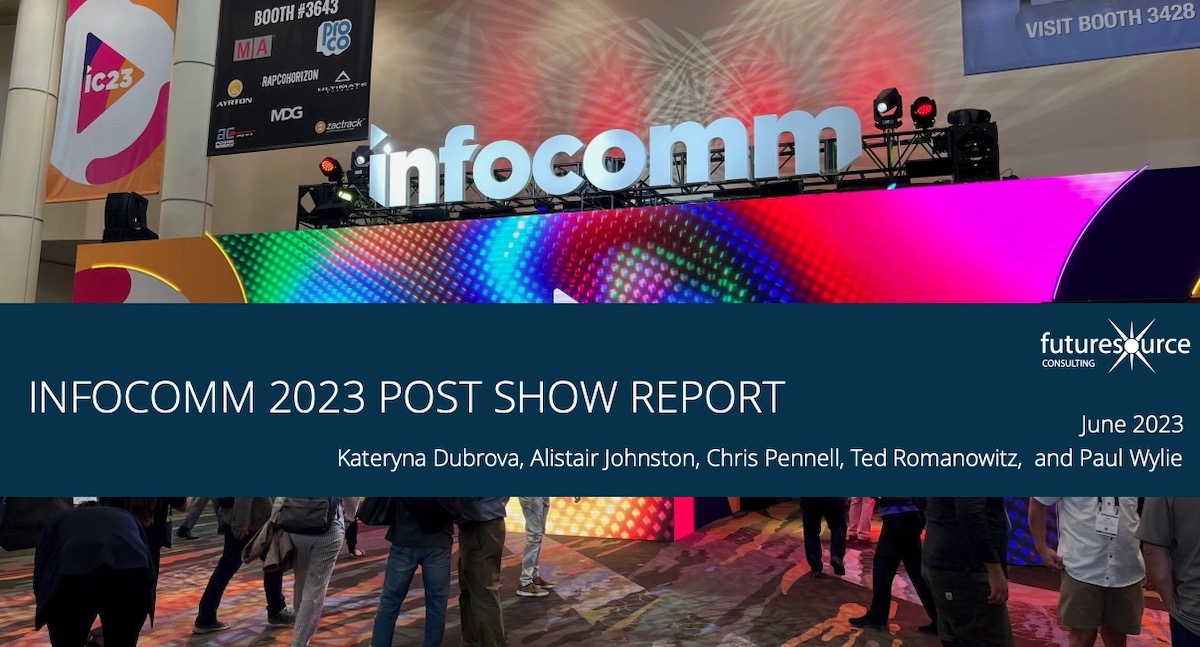
MiniLED Mainstreaming, While True MicroLED For Pro Displays Still Years Off: Futuresource InfoComm Report
July 20, 2023 by Dave Haynes
The UK-based research firm Futuresource sends teams of analysts to the major pro AV trade shows, and there were several people in Orlando last month for InfoComm – resulting in part in a round-up deck that the company kindly makes available as a free download to the industry at large.
Portland, OR-based Ted Romanowitz does the pro display work for the company, and he has three summary slides in a deck that also covers areas like collaboration and pro audio. Here are some of his takeaways from InfoComm …
Mature Technologies Seek Differentiation to Extend Product Life Cycles
Innovation of mature pro AV technology was more elusive but certainly present at Infocomm 2023 as brands seek to gain market share. Although LED makes much noise, Projection, Flat Panel, and Interactive Flat Panel displays combined for nearly three-quarters of global Pro Display value in 2022. Expected to decline over the decade collectively, brands are innovating in unique ways to sustain revenue as long as possible.
Affordability remains the most powerful value proposition for LCD flat panels versus LED; the former is expected to hold that advantage for a few more years. Cost reduction was a common theme across brands. Innovation focuses on picture quality, ease of installation and improved usability.
LED Is Evolving
Three new generations of Direct View LED displays were exhibited at Infocomm 2023, in addition to traditional Surface Mounted Devices (SMD) that have dominated the Pro AV global marketplace for over a decade.
Unlike 18 to 24 months ago, the path of innovation is established and simply a matter of when, not if, these strategic inflexion points occur. In anticipation, several brands have future-proofed their platform architecture to evolve with LED technology.
Integrated Matrix Device (IMD) has largely overcome the image quality issues, such as colour and brightness uniformity and cross-talk within and across packages. IMD packages are now widely available in mass production and implemented by many LED brands with admirable image results.
Several IMD variations are available, including 2, 4 and 16 in one. A key benefit of IMD is reducing the number of SMT line picks and places by a factor of the number of pixels within the package. As IMD volumes ramp, ASPs are expected to decrease 5-10% in 2023.
Differentiating LED Solutions: Many brands also demonstrated market segment-specific LED designs. Optimising for specific vertical market segments was well showcased in LG’s booth with specific LED solutions highlighted for the control room, broadcast, corporate & education, media & advertising, museums & exhibits, consumer and retail.
MiniLED Is Mainstreaming
MiniLED is now widely defined as a flip chip on board (CoB), where 100 to 200-micron pixels are mass transferred to a PCB with passive driver technology, often a common cathode.
At ISE, several manufacturers predicted that MiniLED would reach mass production by the end of 2023. Samsung, LG and Unilumin have obtained that milestone, ramping up volumes to 3k6K square meters of monthly output. Others will follow in the next six months as colour and brightness uniformity and quality improve to acceptable levels to pass factory acceptance tests. As yields improve, manufacturing costs will decrease in the 2024 calendar year, driving another decline in ASP erosion in UNPP driving price reductions in larger pixel pitches as well.
Flip Chip CoB will require millions of dollars in R&D and manufacturing investment. As such, Futuresource anticipates that 10-12 global factories will dominate.
True MicroLED Vs What’s Marketed As MicroLED
Many (manufacturers) are inaccurately promoting their LED solutions as MicroLED because it is a virulent industry buzzword. While we are beginning to see technology demonstrations of True MicroLED, it will take a few years to become broadly available in the marketplace. True MicroLED is defined as sub-100-micron LED chiplets mass transferred to a TFT backplane with active driver technology.
Samsung showcased their consumer television based on true MicroLED, but has not announced plans to introduce a Pro AV version. BOE showcased a single cabinet of their 0.9mm Chip on Glass (CoG) version of True MicroLED on NovaStar’s stand.
Futuresource expects that True MicroLED will be dominated by 5-7 brands that can leverage their LCD panel expertise to enable the technology, manufacturing and ecosystem required to produce the innovative and highly disruptive display technology that is predicted to allow LED to overcome LCD panel global revenues near the end of the 2020s decade.
The full report, which also gets into exotic areas like AV over IP and AV as a Service, is a free download. They just, as is usually the case, ask for basic details like name, company and email. I wish Futuresource was a bit more forthcoming with other research work touted in PR efforts. I’ve mentioned to them how I need more to work with (like snippets of data) than the bare fact they have produced a new research report. But the reports like this that they push out after ISE and InfoComm are great!



Leave a comment